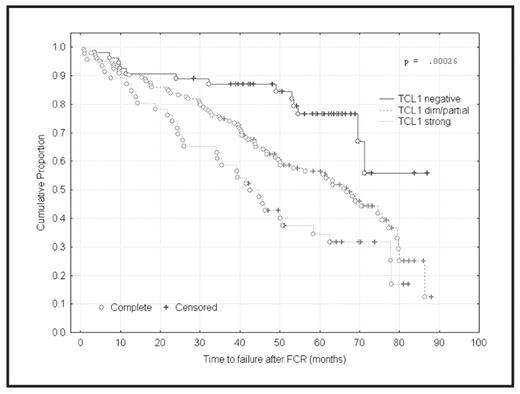Abstract
Body: Expression of the human oncogene TCL1 in transgenic mice produces B-cell tumors that resemble human CLL suggesting a role in B-cell tumorigenesis. TCL1 protein levels in CLL vary, with the highest expression seen in the pre-germinal center subtype which is also correlated with expression of ZAP70. We compare here TCL1 and ZAP70 as markers of response and progression following FCR front-line chemotherapy in a large cohort of patients (pts.).
Methods: Paraffin-embedded pre-treatment bone marrow specimens from 243 CLL pts. who received FCR as frontline therapy between 11/99 and 01/04 were evaluated for TCL1 expression by immunohistochemistry (IHC) using a mouse monoclonal antibody developed in our laboratory. A three-tier grading system (0–2) for expression levels was used. Data on ZAP70 expression (by IHC) and IgVH mutation status was available for 195 and 76 pts., respectively. The series was evaluated for the endpoints of complete response (CR) rates, CR duration, time to failure (TTF),and overall survival (OS) as previously defined (Tam et al., Blood 2008).
Results: 54 (22%) CLL cases expressed no or minimal TCL1 protein (graded as 0), while 143 (59%) cases showed dim/partial TCL1 expression (graded as 1), and 46 (19%) cases expressed moderate to strong TCL1 levels (graded as 2; Table 1). Heterogeneous intratumoral TCL1 expression was seen in a subset of cases, especially within proliferation centers. High TCL1 expression correlated with presenting features of advanced disease, including higher pre-treatment WBC counts (p=0.01), elevated serum beta-2 microglobulin (p=0.01) and unmutated IgVH genes (p = .0007).
Most significantly, high TCL1 expression levels predicted failure to attain a CR (p=0.038), shorter TTF (p=0.0003), and inferior OS (p=0.003) following FCR therapy. Although ZAP70 and TCL1 were positively correlated (R = 0.24), TCL(−) cases were found in both the ZAP70(+) and ZAP70(−) subsets. Expression of ZAP70 was also associated with shorter TTF (p=0.004), and OS (p=0.02) but not failure to attain a CR (p=0.93) after FCR therapy.
Conclusions: In CLL pts initially treated with FCR, strong TCL1 expression by IHC, unlike ZAP70, is predictor of failure to attain a CR and is a prognostic marker of inferior outcome.
| TCL1 (n=243) versus ZAP70 (n=195) expression by IHC . | |||
|---|---|---|---|
| . | . | IHC ZAP(−) (n=75) . | IHC ZAP(+) (n=120) . |
| TCL1 | 0 (n=54) | 23 | 21 |
| 1 (n=143) | 47 | 69 | |
| 2 (n=46) | 5 | 30 | |
| TCL1 (n=243) versus ZAP70 (n=195) expression by IHC . | |||
|---|---|---|---|
| . | . | IHC ZAP(−) (n=75) . | IHC ZAP(+) (n=120) . |
| TCL1 | 0 (n=54) | 23 | 21 |
| 1 (n=143) | 47 | 69 | |
| 2 (n=46) | 5 | 30 | |
Figure
Disclosures: Off Label Use: rituximab is not licensed for CLL.
Author notes
Corresponding author


This feature is available to Subscribers Only
Sign In or Create an Account Close Modal